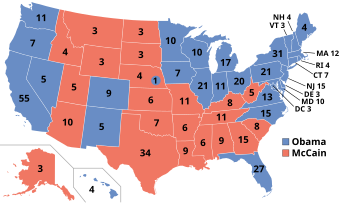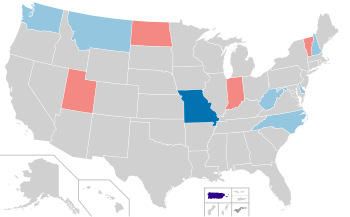2008 United States elections
| ← 2006 2007 2008 2009 2010 → ← 2007 2008 2009 → Presidential election year | |
| Election day | November 4 |
|---|---|
| Incumbent president | George W. Bush (Republican) |
| Next Congress | 111th |
| Presidential election | |
| Partisan control | Democratic Gain |
| Popular vote margin | Democratic +7.2% |
| Electoral vote | |
| Barack Obama (D) | 365 |
| John McCain (R) | 173 |
 | |
| 2008 Presidential election results map. Blue denotes states/districts won by Democrat Barack Obama, and Red denotes those won by Republican John McCain. Numbers indicate electoral votes won by each candidate. | |
| Senate elections | |
| Overall control | Democratic Hold |
| Seats contested | 35 of 100 seats (33 seats of Class II + 2 special elections) |
| Net seat change | Democratic +8 |
 | |
| 2008 Senate election results map Democratic hold Republican hold Democratic gain | |
| House elections | |
| Overall control | Democratic Hold |
| Seats contested | All 435 voting seats |
| Popular vote margin | Democratic +10.6% |
| Net seat change | Democratic +21 |
 | |
| 2008 House election results map Democratic hold Republican hold Democratic gain Republican gain | |
| Gubernatorial elections | |
| Seats contested | 13 (11 states, 2 territories) |
| Net seat change | Democratic +1 |
 | |
| 2008 Gubernatorial election results map Democratic hold Republican hold Democratic gain | |
The 2008 United States elections were held on November 4. Democratic Senator Barack Obama of Illinois won the presidential election, and Democrats bolstered their majority in both houses of Congress.
Obama won his party's presidential nomination after defeating Senator Hillary Clinton in the 2008 Democratic primaries. With Republican President George W. Bush term-limited, Senator John McCain of Arizona won the Republican nomination in the 2008 Republican primaries. Obama won the general election with 52.9 percent of the popular vote and 365 of the 538 electoral votes.
Democrats picked up net gains of eight Senate seats and 21 seats in the House of Representatives. They also won a net gain of one gubernatorial seat. The 2006 elections and 2008 elections represented the first time since the 1930s that one party made substantial gains in Congress in two consecutive elections.[1][2]
The major theme during the campaign was the American public's general desire of change and reform from both Washington and the policies of President Bush. The economy and other domestic policies were also dominant issues, especially during the last months of the campaign after the onset of the 2008 economic crisis.
Federal races
President
Senator Barack Obama of Illinois was the Democratic nominee, and Senator John McCain of Arizona was the Republican nominee. Incumbent President George W. Bush was ineligible for re-election per the 22nd Amendment, which limits a president to two terms, and incumbent Vice President Dick Cheney declined to run for the office.
The 2008 presidential election was the first since 1952 in which neither an incumbent president nor an incumbent vice president was a candidate.
Senator Obama won the number of electors necessary to be elected president and was inaugurated on January 20, 2009.[3]
United States Senate
The 33 seats in the United States Senate Class 2 were up for election, plus special Senate elections in Mississippi and Wyoming. The resignation of Mississippi Senator Trent Lott, and the death of Wyoming Senator Craig L. Thomas, both Class 1 senators, meant that both of those states' senate seats were up for election. The Democrats won 8 seats while the Republicans did not gain a seat.
United States House of Representatives
All seats in the House were up for election, including seats of the 435 voting representatives from the states and the 6 non-voting delegates from the District of Columbia and five U.S. territories. This marked the first time that the commonwealth of the Northern Mariana Islands selected a delegate to Congress.
Democrats won the nationwide popular vote for the House of Representatives by 7.2 percentage points,[4] gaining 21 seats. They increased their total number of seats to 257, the largest number of seats held by either party in the House since Democrats lost control of Congress in the 1994 elections.
State races
Governors
Eleven of the fifty United States governors were up for re-election, as were the governorships of two U.S. territories. Eight incumbent state governors were running for re-election, while the retirements of Ruth Ann Minner of Delaware, Matt Blunt of Missouri, and Mike Easley of North Carolina left those gubernatorial positions open. The incumbent governors of Puerto Rico, Aníbal Acevedo Vilá, and American Samoa, Togiola Tulafono, were also up for re-election.
The only governorship that changed party hands was in Missouri: Democrat Jay Nixon was elected to replace Blunt, who chose to retire instead of seeking a second term.
State legislatures
This section needs expansion. You can help by adding to it. (November 2008) |
The New Hampshire Senate saw the election of the first ever female majority. This is first time this has occurred in any chamber of any state legislature in United States history.[5]
The New York State Assembly, New York State Senate, and Governor's mansion were controlled by the Democrats for the first time since the Great Depression.
Overall, the Democrats took control of six legislative bodies to the Republicans' four. Democrats took control of the Delaware House of Representatives, for the first time since 1985, the Montana House of Representatives, the Nevada Senate, the New York State Senate, for only the second time since WWII, the Ohio House of Representatives, and the Wisconsin State Assembly. Republicans took control of the Montana Senate; both houses of the Tennessee General Assembly, for the first time since reconstruction; and the Oklahoma Senate, for the first time in state history.
After the election, Democrats controlled both houses in the state legislatures of 27 states: Alabama, Arkansas, California, Colorado, Connecticut, Delaware, Hawaii, Illinois, Iowa, Louisiana, Maine, Maryland, Massachusetts, Minnesota, Mississippi, Nevada, New Hampshire, New Jersey, New Mexico, New York, North Carolina, Oregon, Rhode Island, Vermont, Washington, West Virginia, and Wisconsin.
Republicans controlled both houses in the state legislatures of 14 states: Arizona, Florida, Georgia, Idaho, Kansas, Missouri, North Dakota, Oklahoma, South Carolina, South Dakota, Tennessee, Texas, Utah, and Wyoming.
Eight states had divided legislatures: Alaska, Indiana, Kentucky, Michigan, Montana, Ohio, Pennsylvania, and Virginia.
Nebraska has a unicameral non-partisan legislature.
Initiatives and referenda

- State constitutional amendments prohibiting same-sex marriage are passed in three states: Arizona, California, and Florida. The measures in Arizona and California ban same-sex marriage only, while Florida bans both same-sex marriage and civil unions. California is the first state to ban same-sex marriage after having legalized it previously.
References
- ^ Barbara Bradley Hagerty & Deborah Tedford (November 4, 2008). "Democrats Poised For Landslide Wins In House". NPR.
- ^ Matt Bai (June 8, 2010). "Democrat in Chief?". New York Times.
- ^ "Obama wins historic US election". BBC. November 5, 2008.
- ^ "Statistics of the Presidential and Congressional Election of November 4, 2008" (PDF). U.S. House of Reps, Office of the Clerk. Retrieved 10 April 2017.
- ^ "New Hampshire Senate Makes History". ABC News. December 7, 2008.
Further reading
- Barreto, Matt A., et al. ""Should They Dance with the One Who Brung'Em?" Latinos and the 2008 Presidential Election." PS: Political Science & Politics (2009) 41#4 pp: 753-760. online[permanent dead link]
- Bligh, Michelle C., and Jeffrey C. Kohles. "The enduring allure of charisma: How Barack Obama won the historic 2008 presidential election." The Leadership Quarterly (2009) 20#3 pp: 483-492. online
- Campbell, James E. "An exceptional election: Performance, values, and crisis in the 2008 presidential election." The Forum (2009) Vol. 6. No. 4. online
- Crotty, William J. Winning the presidency 2008 (Routledge, 2015).
- Jacobson, Gary C. "The 2008 Presidential and Congressional Elections: Anti‐Bush Referendum and Prospects for the Democratic Majority." Political Science Quarterly (2009) 124#1 pp: 1-30. online
- Panagopoulos, Costas, ed. Strategy, Money and Technology in the 2008 Presidential Election (Routledge, 2014).
External links
- United States Election 2008 Web Archive from the U.S. Library of Congress
